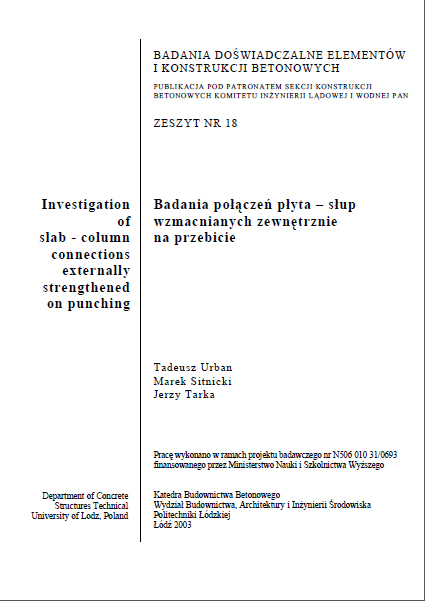Abstract
The research project included execution and experimental testing of 12 natural scale specimens, being a part of rein-forced concrete flat slab with a fragment of column. The slab’s thickness was 18cm, the overall dimensions of 2,3×2,3m and the fragment of column was square in cross section with a side length of 25cm. The main aim of the research was ex-perimental verification of the strengthening concept against punching shear by fixing additional external reinforcement to the upper (tension) surface of the slab. This method uses the relationship between punching capacity and longitudinal rein-forcement ratio, called also mechanical reinforcement ratio (ρ·fy / fc). As external reinforcement flat irons and CFRP strips were used.
The research was carried out in 3 series, each consisting of 4 specimens. All slabs in every series were cast from the same concrete mixture C35/45 class. In every series a specimen without strengthening was made for comparison.
The first series concerned the possibility of strengthening with flat irons. The variables were the number of flat irons used and the type of fixing to the slab. The most efficient turned out to be fixing flat irons to the slab by glue and simulta-neously by anchoring bolts. This specimen reached the ultimate punching capacity of 825kN, what in relation to the un-strengthened specimen (500kN) gave the increase of load carrying capacity of 65%.
The second series used CFRP strips as external reinforcement for strengthening. One of the specimens had 8 strips (cross-sectional dimensions of a single strip 1,4×90mm, As = 126 mm2) fixed to the slab’s surface by glue according to technology advised by Sika. The increase of load carrying capacity of this specimen in relation to reference slab turned out to be only 11%. At the same time a specific type of failure was observed for the specimen strengthened this way, leading to the debonding of CFRP strips on the edge of a shear crack at the upper surface of the slab. To limit the negative effect of strips’ debonding from concrete, the next specimen had the strips additionally fixed by anchoring bolts in the predicted place of shear crack outlet. This technique resulted in the increase of punching capacity up to 26% over reference slab. The third specimen had a doubled number of strips (16 units) for strengthening. They were fixed in two layers, one on the other and simultaneously additionally anchored by bolts. This specimen reached the increase of load carrying capacity of 36%.
The third series was dedicated to a problem frequently occurring in practice, which is the decrease of punching capacity due to the displacement of slab’s upper reinforcement downwards. This series, except the reference specimen with a rein-forcement cover of 2cm, had slabs with cover 5cm thick. One of these specimens also remained unstrengthened and served as a second element for comparison. The remaining two slabs were strengthened with 8 flat irons fixed by glue and anchor-ing bolts. In one case the strengthening was installed to the slab before placing any load and in the other, the operation was performed under the load applied to the specimen. Firstly, the load was applied to the test slab, reaching the level of operat-ing technological load, assuming the correct cover of steel reinforcement. Due to the reinforcement displacement this amount of load significantly exceeded the operating level and corresponded to the 70% of the ultimate punching load. The next step was to reduce the load approximately to 50% of the ultimate punching load. After stabilisation of deflections, the external strengthening was mounted to the slab. Few hours later, which were needed for the binding of glue, the testing proceeded up to slab’s failure. The following results of punching capacity were obtained:
- the reference specimen with a nominal cover (2cm) 475kN,
- the reference specimen with an increased cover (5cm) 367kN,
- the specimen strengthened under zero load 700kN (an increase of 91%),
- the specimen strengthened under the load 675kN (an increase of 84%).
The research studies and obtained results confirmed the effectiveness of the presented in the paper concept of strengthening flat concrete slabs against punching shear failure by increasing mechanical reinforcement ratio against bending.
References
Hassanzadeh G., Sundqvist H.: Strengthening of Bridge Slabs on Columns. Nordic Concrete Research [online], 1998, s.12, [dostęp: 27.10.2003], www.itn.is/ncr/publications/pub-21.htm 1998;
Soudki K., Van Zwol T., Sherping R.: Strengthening of Interior Slab-Column Connections with CFRP Strips. FRPCS-6, Singapore, 8-10 July 2003, Edited by Kiang Hwee Tan, s. 1137÷1146;
El-Salakawy E.F., Polak M.A., Soudki K.A.: New Shear Strengthening Technique for Concrete Slab-Column Connections. ACI Structural Journal, V.100, No. 3, May-June 2003, s. 297-304;
Adetifa B., Polak M.A.: Retrofit of Slab Column Interior Connections Using Shear Bolts. ACI Structural Journal, V.102, No.2, March-April 2005, s. 268-274;
Binici B., Bayrak O.: Punching Shear Strengthening of Reinforced Concrete Flat Plates Using CFRPs. Journal of Structural Engi-neering, ASCE, V.129, No. 9, September 2003, s. 1173-1182;
Binici B., Bayrak O.: Use of Fiber-Reinforced Polymers in Slab-Column Connection Upgrades. ACI Structural Journal, V.102, No.1, January-February 2005, s. 93-102;
Muttoni A., Fernandez Ruiz M., Kunz J.: Nachtragliche Durchstanzbewehrung zur Verstarkung von Stahlbetonflachdecken”. Bau-ingenieur, Dezember 2008, s. 503÷511;
Urban T.: Wzmacnianie stropów żelbetowych typu płyta-słup w strefach podporowych. Inżynieria i Budownictwo, Nr 10/2005, s. 547÷550;
Urban T.: Wzmacnianie monolitycznych węzłów płyta-słup materiałami „CFRP”. LI Konf. Nauk. KILiW PAN i KN PZITB, Kry-nica 2005, Tom 3, s. 121÷128;
Urban T. S.: Przebicie w żelbecie. Wybrane zagadnienia. Politechnika Łódzka, Zeszyty Naukowe Nr 959, Łódź 2005, ss. 348;
Urban T.: Diagnostyka i wzmacnianie płyt żelbetowych na przebicie. Przegląd Budowlany 11/2008, s. 33÷40;
Noakowski P.: Wzmocnienie stropów biurowca. Duże ugięcia i niedostateczna nośność na przebicie. Problemy remontowe w budownictwie ogólnym i obiektach zabytkowych. DWE, Wrocław 2006, s. 576÷588,

